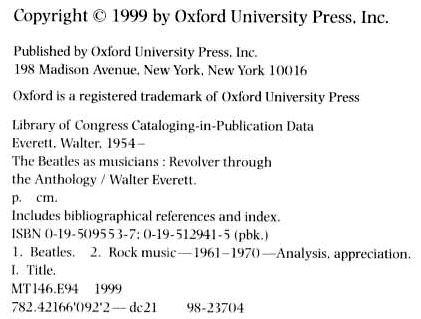 p 98
The
Beatles in Early 1967
p 98
The
Beatles in Early 1967
Procol HarumBeyond |
|
|
PH on stage | PH on record | PH in print | BtP features | What's new | Interact with BtP | For sale | Site search | Home |
|
A handful of Procol references from the excellently donnish Beatle tome in two 400-page+ volumes by Walter Everett, Associate Professor of Music in Music Theory at the University of Michigan. Not sure about his Paramounts chronology, but the books are very enlightening indeed about the Beatles' compositions and playing..
 p 98
The
Beatles in Early 1967
p 98
The
Beatles in Early 1967
Brian Epstein’s interest in the Saville Theatre has been noted; by late 1966, no longer occupied on a daily basis by his nontouring Beatles, he continued to add an occasional act to his management roster, such as the Paramounts, who became [sic] Procol Harum. Then in January 1967, NEMS merged with Robert Stigwood (manager of the Who and Cream), to whom Epstein relinquished managerial duties. Brian continued to negotiate for the Beatles, anticipating the October expiration of his management contract with the group, and in fact secured for them new nine-year contracts with EMI and Capitol in January that multiplied the group’s recording royalties from 7 cents per LP and 1 cent per single in the United Kingdom (and half that in the United States) to a percentage of wholesale prices, on a sliding scale of 10–15 percent in the United Kingdom (and 10–17.5 percent in the United States). In April 1967 the Beatles renewed their legal partnership as Beatles & Co., binding until 1977.
p 125 The Summer of 1967
Five days later Track 2 [of All You Need is Love] received piano from
Martin, heard best in the introduction in the barrelhouse right-hand octave
tremolos, and banjo from an uncharacteristically vaudevillian Lennon, and vocals
went onto Tracks 3 and 4; these additions were mixed to a new Track 1 on June
21. The Beatles asked Martin for an orchestral score and gave him carte blanche
for the long ending that was to have been faded out in mixing; for this he chose
to arrange a mélange of incipits from Bach’s F-major keyboard invention for two
trumpets (one of which would be played by Penny Lane’s David Mason),
Glenn Miller’s arrangement of In the Mood for two tenor saxophones, and
Greensleeves for celli and violins. [Footnote: Bach was in the air: the
C-major prelude from Book 1 of the Well-Tempered Clavier had just been
woven into Gary Brooker’s piano part in Repent Walpurgis (Procol
Harum, May 1967)].
 For good measure, he wrote out brass parts, doubling his
piano octaves, for Le [sic] Marseillaise
as an opening fanfare, presumably to reflect the global nature of the broadcast.
The chamber orchestra rehearsed with the Beatles on June 23, and all rehearsed
with the BBC television crew on the 24th. June 25 saw the live
broadcast from Studio One, a seven-minute segment showing the group adding
backing vocals to the end of the instrumental track, after which Martin
announced, ‘We’ll get the musicians in now’; the Beatles always referred to
their classically trained session players as ‘the musicians’ …
For good measure, he wrote out brass parts, doubling his
piano octaves, for Le [sic] Marseillaise
as an opening fanfare, presumably to reflect the global nature of the broadcast.
The chamber orchestra rehearsed with the Beatles on June 23, and all rehearsed
with the BBC television crew on the 24th. June 25 saw the live
broadcast from Studio One, a seven-minute segment showing the group adding
backing vocals to the end of the instrumental track, after which Martin
announced, ‘We’ll get the musicians in now’; the Beatles always referred to
their classically trained session players as ‘the musicians’ …
p 154 The Beatles in Early 1968
The verse structure in Lady Madonna is unique among Beatles songs, but it is similar to Old MacDonald in that its opening phrase is truncated for an appearance after the bridge. A repeated four-bar phrase (A–B) is followed by an eight-bar bridge section (C) that neatly tonicizes bIII (C major) before chorally intoning the retransitional V 7/4-3 refrain, with the same chords, A–C–E, that form the harmonic guideposts of two other McCartney songs, Another Girl and Birthday. The retransition leads to a four-bar rehearing of the opening phrase and an instrumental tag ending (D). The ‘bridge’ extends the repeated-note stepwise descent in the bass from the Hello Goodbye chorus and the nearly-an-octave examples in the Who’s Pictures of Lily (April 1967) and Procol Harum’s Whiter Shade of Pale (May 1967), repeated in David Bowie’s later Changes (April 1972); here allowing one registral break, the descent extends a full twelfth.
|
PH on stage | PH on record | PH in print | BtP features | What's new | Interact with BtP | For sale | Site search | Home |